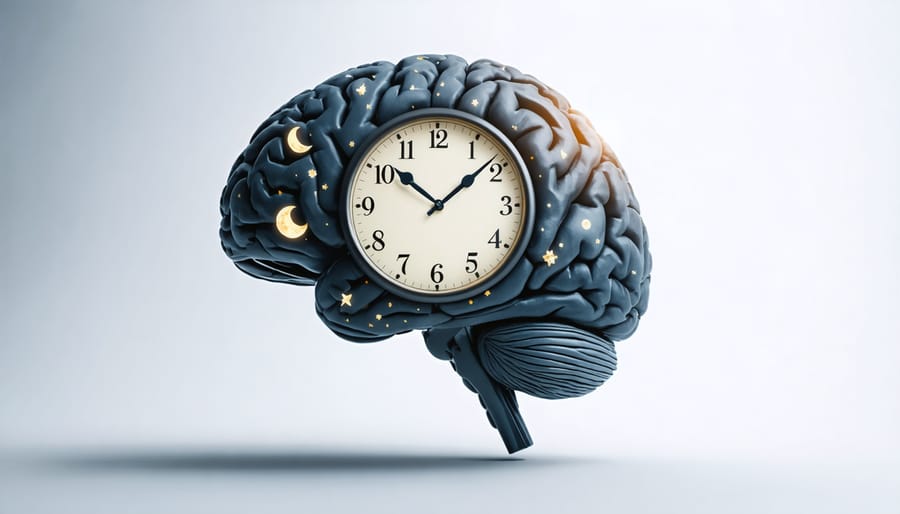The transition to daylight saving time can cause immediate sleep disturbances for many people. Moving the clocks forward by one hour leads to a sudden shift in our sleep-wake cycle, which is regulated by our internal circadian rhythm. This abrupt change can result in difficulty falling asleep, reduced sleep quality, and shorter sleep duration. Studies have shown that in the days following the time change, people may lose an average of 40 minutes of sleep per night. This sleep loss can lead to daytime fatigue, decreased alertness, and impaired cognitive function. Additionally, the mismatch between our internal clock and the new social clock can cause a phenomenon known as “social jet lag,” which may further contribute to sleep issues. To minimize these short-term effects, experts recommend gradually adjusting your sleep schedule in the days leading up to the time change, maintaining a consistent sleep routine, and creating a sleep-friendly environment to promote better rest.

Long-Term Health Consequences
The long-term health effects of daylight saving time are concerning. Research suggests that the biannual time shifts can lead to ongoing sleep disruption, which may increase the risk of developing chronic conditions. Consistently losing sleep can weaken the immune system, making individuals more susceptible to illnesses. Additionally, sleep deprivation has been linked to a higher likelihood of obesity, as it disrupts hormones that regulate hunger and metabolism. Cardiovascular health may also suffer, with studies indicating a potential rise in heart attacks and strokes in the days following the time change. Furthermore, the cumulative effects of sleep loss can lead to long-term cognitive impairments, such as difficulty with memory, concentration, and decision-making. While more research is needed to fully understand the lasting impacts of daylight saving time on health, it is clear that prioritizing consistent, quality sleep is essential for maintaining overall well-being and preventing chronic diseases. By establishing healthy sleep habits and allowing the body to adjust gradually to time changes, Canadians can take proactive steps to protect their long-term health.
Sail through Daylight Savings with tips and strategies aimed at ensuring a smoother transition.
Increased Risk of Accidents and Injuries
Workplace Accidents
The start of daylight saving time sees a significant spike in workplace accidents and injuries. A study published in the Journal of Applied Psychology found that the number of injuries at work increased by 5.7% on the Monday following the transition to daylight saving time. The research also revealed that workers lost 40 minutes of sleep on average, leading to fatigue and reduced alertness. This increased risk of accidents was particularly evident in hazardous occupations such as mining and construction. Employers and employees should be aware of these potential dangers and take extra precautions to ensure safety in the days following the time change. Strategies such as adjusting work schedules, promoting rest breaks, and encouraging open communication about fatigue can help mitigate the risks associated with the transition to daylight saving time.

Traffic Accidents
The switch to daylight saving time can also lead to an increased risk of traffic accidents. Studies have shown that in the days following the time change, there is a significant spike in car crashes, particularly during the morning commute. This is likely due to the combination of sleep deprivation and adjusting to darker morning conditions. Drowsy driving can impair reaction times, decision-making, and overall cognitive function, similar to the effects of driving under the influence of alcohol. To minimize the risk of accidents, it’s essential to prioritize getting enough sleep leading up to the time change and to be extra cautious when driving in the days following the switch. If possible, consider adjusting your schedule to allow for a more gradual transition and avoid driving during peak drowsy times.
Mental Health Impacts
Seasonal Affective Disorder
For those with Seasonal Affective Disorder (SAD), the shorter days following the fall time change can intensify symptoms. SAD is a type of depression linked to reduced exposure to sunlight, leading to mood changes, fatigue, and sleep disturbances. The sudden shift in daylight hours disrupts the body’s internal clock, exacerbating SAD symptoms. Individuals may experience increased feelings of sadness, irritability, and a lack of energy. The time change can also worsen sleep problems associated with SAD, such as difficulty falling asleep or staying asleep. To manage SAD symptoms during this transition, experts recommend maintaining a consistent sleep schedule, getting outside during daylight hours, and using light therapy boxes to simulate sunlight exposure. If symptoms persist or worsen, it’s important to consult with a healthcare professional for additional support and treatment options.
General Mood Disturbances
The transition to daylight saving time can lead to temporary mood disturbances for many individuals. As the body’s internal clock adjusts to the new schedule, people may experience increased irritability, fatigue, and a general sense of being “off.” This is due to the disruption of the circadian rhythm, which regulates the sleep-wake cycle and influences mood. Studies have shown that the time change can exacerbate symptoms of depression and anxiety, particularly in the days immediately following the shift. To minimize these effects, experts recommend maintaining a consistent sleep schedule, even on weekends, and engaging in stress-reducing activities like exercise, meditation, or spending time outdoors. It’s also important to be patient with yourself and others, as it may take a few days for the body and mind to fully adapt to the new schedule.
Tips for Adjusting to Daylight Saving Time
Gradual Sleep Schedule Adjustments
To gradually adjust your sleep schedule before the time change, start by shifting your bedtime and wake time by 10-15 minutes each day in the week leading up to the transition. This allows your body to slowly adapt to the new schedule, minimizing the impact on your internal clock. Maintain a consistent sleep routine during this period, going to bed and waking up at the same time each day, even on weekends. Ensure your bedroom is dark, quiet, and cool to promote optimal sleep. Additionally, avoid exposure to bright light, especially from electronic devices, in the evening as it can interfere with your body’s natural sleep-wake cycle. Engaging in relaxing activities like reading, meditation, or gentle stretching before bed can also help you wind down and prepare for sleep. By making these gradual adjustments, you can help your body more smoothly transition to the new time, reducing the potential negative health effects associated with daylight saving time.

Lifestyle Habits for Better Adaptation
To ease the transition during daylight saving time, focus on maintaining a consistent sleep schedule by going to bed and waking up at the same time each day, even on weekends. Engage in regular exercise, preferably outdoors during daylight hours, to boost energy levels and regulate your internal clock. Eating a balanced diet rich in fruits, vegetables, lean proteins, and whole grains can also help stabilize mood and improve sleep quality. Avoid heavy meals, caffeine, and alcohol close to bedtime. Exposure to natural light is crucial for adjusting to the new schedule, so try to spend time outside or near windows during the day. In the evenings, minimize exposure to blue light from electronic devices, which can disrupt sleep patterns. Consider using dim, warm lighting and engaging in relaxing activities like reading or taking a warm bath before bed to promote a restful night’s sleep.
Conclusion
Daylight saving time can have significant impacts on our health and well-being, as evidenced by the numerous studies highlighting the potential risks associated with the time change. From sleep disruption and increased risk of heart attacks to heightened chances of accidents and mood disturbances, the bi-annual shift can take a toll on both physical and mental health. It is crucial for Canadians to be aware of these potential effects and take proactive steps to mitigate them, such as maintaining a consistent sleep schedule, prioritizing self-care, and seeking support when needed. By understanding the challenges posed by daylight saving time and implementing strategies to cope with the transition, individuals can better protect their health and well-being during this period of adjustment.

